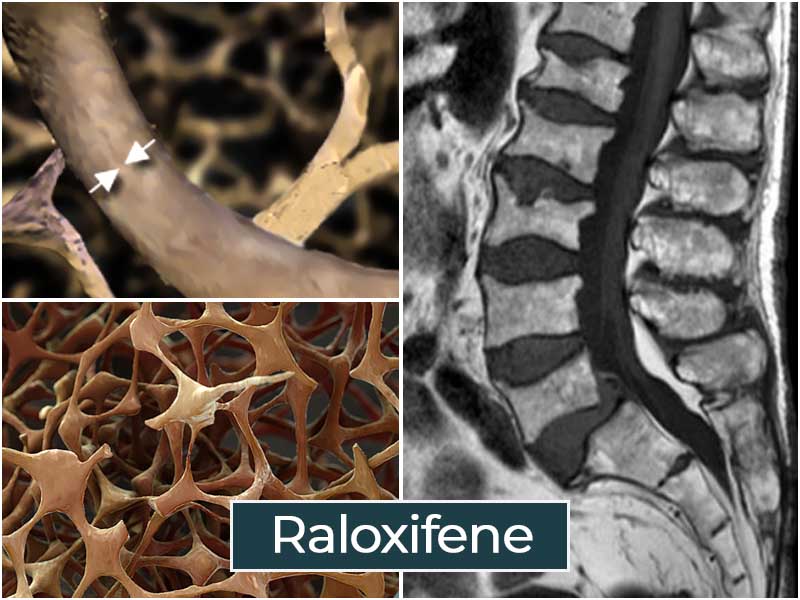Raloxifene

Raloxifene is a medication prescribed by most doctors for the treatment and prevention of osteoporosis in postmenopausal women and those on glucocorticoids. Osteoporosis is a bone disease in which the quality and the density of bone are reduced. As a result, the bones become more fragile and more likely to break from a fall or in serious cases, from minor bumps or sneezing.
It was also approved for medical used in 2007 for reducing the risk of postmenopausal women with osteoporosis from the risk of invasive cancer and postmenopausal women at high risk of invasive breast cancer. However, this drug is not a breast cancer treatment drug. It can only help prevent cases of invasive estrogen receptor-positive breast cancer. Raloxifene will not treat hereditary breast cancer due to genetic mutations nor can it prevent cancer from coming back.
Raloxifene is a selective estrogen receptor modulators or SERMs. SERMs are synthetic molecules that interfere with the receptors that receive estrogen molecules. Depending on the tissue, it can either enhance or block the effect of estrogen. It works by mimicking the effects of estrogen in the body to increase bone density. Estrogen is the main female sex hormone with many functions. Bone, breast and uterine tissue; cholesterol metabolism are all affected by this hormone. During the menopausal period, estrogen hormone starts to decrease and this affects the tissues that are normally responsive to estrogen. A continues declination of estrogen results in an increased breakdown of bone which can lead to a decreased bone density. Raloxifene reverses the excessive breakdown of the bone during the menopausal period and causes an increase in bone density.
Why Buy Raloxifene?
Raloxifene was approved for medical use in the U.S since 1997. This medication helps manage and prevent osteoporosis and can significantly reduce the risk of a spinal fracture. It’s available as generic and brand names in the market and is one of the most prescribed medications in the United States. Unlike other osteoporosis medication, Raloxifene causes few cases of deep vein thrombosis, endometrial cancer, pulmonary embolism, and cataract.
How to Take Raloxifene?
Raloxifene comes in a tablet form for you to take by mouth. Take this exactly as directed by your physician. The typical recommended dose is 60 mg tablet once a day. You can take it any time of the day with or without meals. Take it at the same time each day. Do not take more or less than what is recommended to you. Continue taking this even if you feel well. Do not stop taking your medication without informing your physician.
For the treatment or management of osteoporosis, supplemental vitamin D or calcium is needed for the diet. Women who are at a postmenopausal stage require an average of 1500mg/day of elemental calcium.
What are the side effects of Raloxifene?
Raloxifene can affect you in unwanted ways. Although it can help you manage and prevent bone breakdown or help prevent invasive breast cancer, taking them can also lead to joint pain, dizziness, leg cramps, sinus problems, hot flashes, and vomiting. These side effects are just mild. Serious side effects are also possible. If you experience any of the following serious side effects, contact your doctor right away:
- Sudden onset of weakness or numbness on one side of the body
- Chest pain, rapid breathing, cough, and fast heart rate
- Confusion, headache, speech, vision or balance problems
- Swelling in the hands or feet
- Flu-like symptoms such as sire throat, body aches, chill and fever
- Signs of allergic reactions like difficulty breathing, swelling of the face, lips, throat, and hives
- Severe lower back pain
- Painful urination
- Vaginal bleeding
- Breast tenderness or pain
We care for your safety
- Raloxifene can only mimic the effect of estrogen on bone tissue. It does not mimic the effect of estrogen in the uterine and breast tissue.
- Long-term use does not carry the risk of breast cancer or cancer of the lining of the womb. However, it can increase your risk of blood clots in the veins.
- Some medications may interact with Raloxifene when taken. You should inform your doctor of any medications you are taking including over-the-counter drugs, prescription drugs, vitamins or herbal supplements.
- Certain lifestyle habits also don’t mix well with Raloxifene. Stay away from this medication if:
- You have heart disease
- Liver disease like a failure of the normal flow of the bile from the liver to the intestines
- You have had a stroke
- Severely decrease kidney disease
- High blood pressure
- You have had breast cancer previously
- You smoke
- Vaginal bleeding of unknown cause
- You are pregnant or breastfeeding
- Rare heredity problems of galactose intolerance
- Raloxifene may increase your risk of blood clotting in the veins also known as deep vein thrombosis/pulmonary embolism. Your risk is higher if you have existing risk factors such as family history, obesity, smoking, and certain blood disorder.
- Your risk of having deep vein thrombosis may temporarily increase if you have experience major trauma, surgery or other illness or condition that results in you becoming immobile for a longer period.
- Use this medication with caution in:
- Women with breast cancer
- Women with a risk or history of stroke or mini-stroke
- Women who have had a raised triglycerides in their blood
- Women with an irregular heartbeat due to a very rapid contraction on the top two chambers of the heart
- You should know that even though this medicine can decrease your chance of developing invasive breast cancer, there is still a risk that you will develop this condition. It is still therefore important for you to have a regular breast exam and mammograms schedule before you start taking Raloxifene.
- If you are taking this medicine to manage or treat osteoporosis, talk to your doctor about things that you can do to stop your condition from getting worse.



